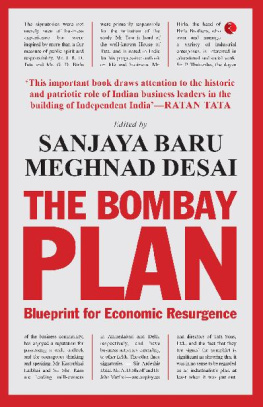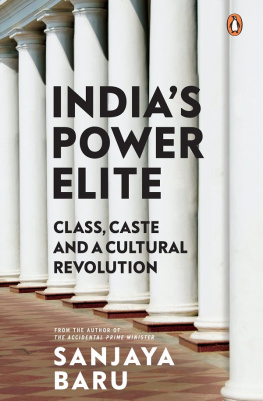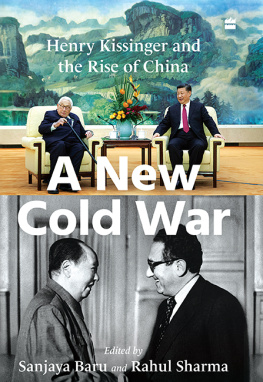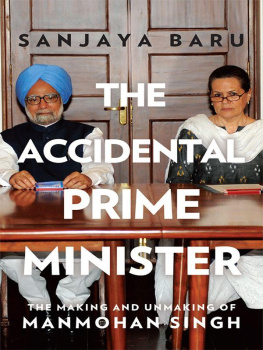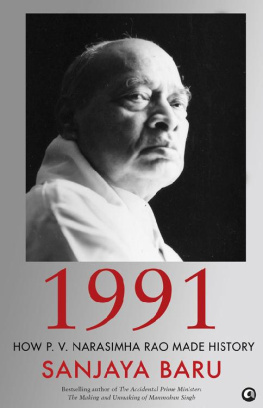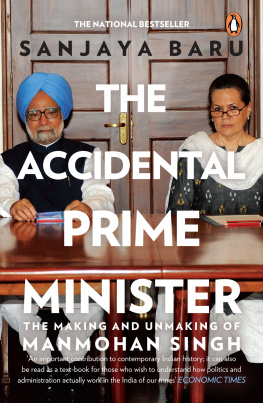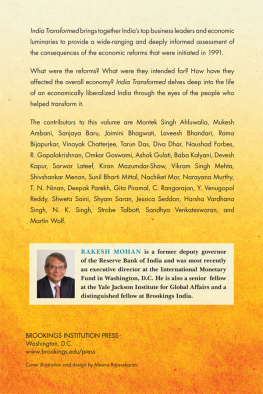Praise for the book
This important book draws attention to the historic and patriotic role of Indian business leaders in the building of Independent India.
Ratan Tata, Chairman Emeritus,
Tata Sons and Chairman, Tata Trusts
Prominent journalist Sanjaya Baru and the eminent economist Meghnad Desai must be congratulated for rescuing from oblivion the Bombay Plan, whose publication was a landmark event in Indias developmental efforts.
Jagdish Bhagwati,
Author of In Defense of Globalization , and
co-author of Indias Tryst with Destiny
A re-reading of the Bombay Plan after 74 years creates a sense of deja vu. The top industrialist and technocrats were struggling with the same issues of todayhow much of government and how much of private, how much of self-reliance and how much of openness (globalisation). The wrenching renditions and pungent critiques in this book, edited by Dr Sanjay Baru and Lord Meghnad Desai, make exciting reading, adding great value to the contemporary debates on the political economy of India. This book is a must read for a 360 degree view of Indias unfolding saga of radical change with inherent continuity.
Dr Amit Mitra, Finance Minister,
Government of West Bengal, and
Former Secretary-General, FICCI.
Published by
Rupa Publications India Pvt. Ltd 2018
7/16, Ansari Road, Daryaganj
New Delhi 110002
Copyright Sanjaya Baru & Meghnad Desai 2018
The views and opinions expressed in this book are the authors own and the facts are as reported by them which have been verified to the extent possible, and the publishers are not in any way liable for the same.
While every effort has been made to trace copyright holders and obtain permission, this has not been possible in all cases; any omissions brought to our attention will be remedied in future editions.
All rights reserved.
No part of this publication may be reproduced, transmitted, or stored in a retrieval system, in any form or by any means, electronic, mechanical, photocopying, recording or otherwise, without the prior permission of the publisher.
ISBN: 978-81-291-xxxx-x
First impression 2018
10 9 8 7 6 5 4 3 2 1
The moral right of the authors has been asserted.
This book is sold subject to the condition that it shall not, by way of trade or otherwise, be lent, resold, hired out, or otherwise circulated, without the publishers prior consent, in any form of binding or cover other than that in which it is published.
CONTENTS
Sanjaya Baru and Meghnad Desai
P.S. Lokanathan
Amal Sanyal
Gita Piramal
Omkar Goswami
Sanjaya Baru
Tulsi Jayakumar and R. Gopalakrishnan
Meghnad Desai
Ajay Chhibber
INTRODUCTION
A UNIQUE DOCUMENT THAT MERITS ATTENTION
Sanjaya Baru and Meghnad Desai
A document of a little over a hundred pages called A Plan of Economic Development for India, written in two parts and published in 194445, generated widespread interest in India and abroad at the time of its publication. The influential American journal Foreign Affairs carried an extensive review written by P.S. Lokanathana distinguished economist, United Nations (UN) official and Editor, Hindustan Times . There was every reason why the document deserved the attention it got. Its authors were none other than J.R.D. Tata, G.D. Birla, Purushottamdas Thakurdas, Kasturbhai Lalbhai, Ardeshir Dalal, Lala Shri Ram, John Mathai and A.D. Shroffall business leaders and economic policymakers of repute.
The documents importance derived not only from its impressive list of authors, but also from the fact that it was a unique document in the history of postcolonial development. Nowhere in the developing world had a group of business leaders come together to articulate such a comprehensive vision for national development that simultaneously promoted their own class interests. In doing so, the Indian capitalist class, led by its business leaders, played a vanguard role in the consolidation of Indias bourgeois revolution, so to speak. By demanding the creation of a single national economic space and seeking social development and agrarian change, a nascent capitalist class played a historic role in national development. It is worth remarking that these business leaders had built up their businesses against considerable odds. They needed the British rulers even though they constantly challenged them with the charge that Indian industry was being neglected to the benefit of their British counterparts. They also befriended the nationalists, fully cognizant of the risks of alienating the foreign rulers.
J.R.D. Tata was head of an industrial house which dealt in many different sectors, but most famously in steel. G.D. Birla was a traditional Marwari family business head, and a friend of Mahatma Gandhi. Kasturbhai Lalbhai was a textile industrialist from Ahmedabad, sympathetic to the nationalist cause. Sir Purushottamdas Thakurdas was the senior leader in this group. He had been drafted into the official committee for a report on the Indian currency problem, and was a liberal leader loyal to the British government. Even so, his experience was considered valuable for drafting the Bombay Plan. The three remaining membersDalal, Shroff and Mathaiwere not industrialists themselves, but managers and administrators in business houses.
The group had a grip on the larger organized sector of Indian industries. All of them wanted the country, when independent, to do well. This is why they formulated the document popularly known as The Bombay Plan. This document has disappeared not just from public memory, but also from undergraduate textbooks of Indian economics.
It is something of a puzzle we need to explore at the outset. The elite of the somewhat small business class, which had grown under a colonial regime, felt that it should take the lead to set out an ambitious programme for economic development (itself a novel idea in the 1940s) as a gesture of helpful partnership with the nationalist leadership, which would be new to the task of governance. The business elite had maintained a friendship with the nationalists while taking care not to antagonise the colonial powers they had to deal with in their daily operations. The new leadership, having to learn on the job, would be heading a new State that would be fragile, and, no doubt, in need of help. The business elite was the Older Brother, knowledgeable in the task of running an economy. It is pertinent to note that it could have used the transition to Independence to establish its hegemony. But far from advocating extensive freedom for business to get on with the job of growth while the State could play the role of a Night Watchman, it gave pride of place to the forthcoming State. In its turn, when the nationalist political leadership did come to power, it spurned the offer of help extended by the business elite and embarked not only on a Statist policy (as advocated by the Bombay Plan) but also on a business-unfriendly strategy. As time passed, the political leadership moved to reverse the power equation between politics and business. Business became subordinate to politics even as it expanded.
This collection of essays is aimed at bringing current policy and academic attention to a document that was not only prescient in its approach to development but was also influential in shaping economic planning and public policy in the first decade of Indias Independence. The Bombay Plan shaped the thinking underlying Indias first and second Five Year Plans (195262). This volume puts together seminal papers published on the Bombay Plan and essays written more recently on it.



